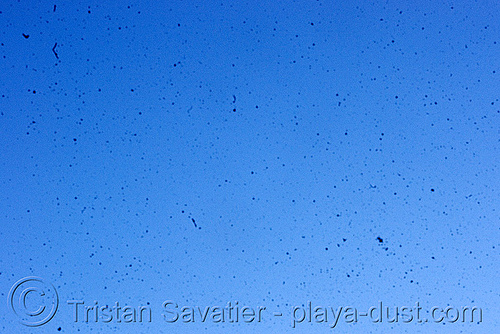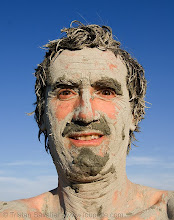
Photo © Tristan Savatier - All Rights Reserved
This is a sensor test photo that i took at Burning Man 2008, with the diaphragm (aperture) closed to the maximum (i.e. maximum F-value, F32) shooting the blue sky. I have never seen as much dust on my sensor. Good thing I know how to clean a CCD sensor :)
I recommend a Giottos Rocket air blower to remove the bulk of the dust, then you can use the wet sensor swabs (with 100% pure methanol optical solution, also called methylic alcohol) to remove sticky particles that don't go with the air blower, if necessary.
Don't put more than a couple of drops of methanol on the swab, otherwise it would be too wet and leave deposit marks on the sensor. You will have to clean several times before getting a clean sensor, especially the first time. To clean, you must sweep the swab on the sensor from side to side. For best results, the width of the swab should the exact width of your sensor, so that you only need one sweep. Swabs made by Visible Dust. are excellent quality, I use those. After sweeping, put back the lens and do a test shot, then zoom on the image and check if there is still dust. usually the dust is located near the corners or near the edges. if you see dust, repeat the process.
To do a test shot, you must set the camera in A mode and close the apperture to the maximum F value (e.g. F32), and take a photo of something uniform, e.g. the sky or just a piece of paper. Set the camera to manual focus and make it completely out of focus, so if you see a dot on the test shot, it will be dust.
Sensor cleaning was painful at the beginning, it took me one hour to get all the dust OFF the first time. But now i can do it in two of three iterations, and it takes 10 min or so, and I am no the least nervous about doing it on my expensive camera.
Also, remember that if you have dust on your sensor, it will probably not show on your photos if you shoot with maximum apperture (i.e. minimum F value, e.g. F2.8 or F3.5). So if you have dust on the sensor and must continue to shoot with the dust, remember to shoot in A-mode (apperture priority) and use maximum apperture, i.e. use the minimum F value of your lens.
Dry-cleaning the sensor with rotating brushes charged with static electricity will work only with the dry, non-sticky particles on the sensor. But it will not cleanup sticky or greasy particles. Those can only be removed with a wet swab. So even if you get one of those dry cleaning brushes (e.g. Arctic Butterfly), sometimes you will still need to use the wet swabs.
NEVER ever use a spray can to blow away the dust inside the camera. The very cold gas out of the air-can would cause irreparable damage (micro-cracks) to your sensor.
There are other CCD cleaning options available, but that's what I use and it works well for me. Or you can pay a professional to do it, but it usually takes several days and it's not cheap, and this is not always possible if you travel. So you'd better learn how to do it yourself.
